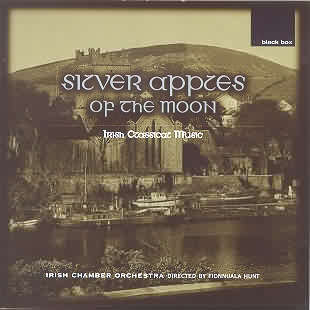SILVER APPLES OF THE MOON: This enigmatic quotation
from Yeats conceals an evocative selection of string music - relating,
in its lush tangy harmonies to the music of Warlock and Moeran. It is
characteristically Irish, at one moment sentimental, at another full
of foot-tapping geniality. Irish classical music really only came into
its own with the advent of the Republic. The composers represented here
all however took equally important parts in Irish musical education
- the two most notable being John F Larchet (a friend of Moeran and
Director of Music at the Abbey Theatre) and Aloys Fleischmann, who from
the early age of 24 held the chair of music at Cork University. It could
well be that the name most familiar on this disc might be that of Joan
Trimble, better known perhaps in her dual role as pianist with her sister
Valerie. Her contribution, a three movement Suite, is in essence
more cogent in idiom that the others (except Fleischmann) the music
having some of the harmonic acerbity of John Ireland. It loses none
of its Irishness in the eloquent slow movement - the Finale an energetic
‘birl’.
Thomas C Kelly (1917-85), who taught at Clongowes Wood
College, has written many arrangements of Irish folk music. His Three
Pieces for Strings dates from 1949. The opening Pastoral (the
enchanting melody written originally for the fairy child’s song
in ‘The Land of Heart’s Desire’) is followed by
a dark hued cello Lament. The final Reel, with its minor
cast, is far more than a piece of dance music. His O’Carolan
Suite in five movements in Baroque style is for solo violin and
strings, and based on melodies of the ancient Irish harper (1670-1738),
Planxty being an old dance form. Arthur Duff’s popular Suite
opens with a reflective melody in traditional Irish dress recalling
Midir’s love for Etain. The cheery ‘Windy Gap’
of Wicklow is followed by a poignant reminiscence of the Messiah performance
of 1742. The Dance of Daemar recalls Tir nan Og and all is swept
away in the final Fiddler’s Reel. John F Larchet’s
Macananty’s Reel just possibly the homecoming of the famous
Fairy King of Scarbo, - is contrasted with his Dirge of Ossian, a
funeral hymn from the Glens of Derry. The most substantial work is however
Fleischmann’s Elizabeth McDermott Roe - the separately published
(1952) 3rd movement of The Humours of Carolan - but its reference
to the Irish harper, unlike Kelly’s, is a transition of the mood
of the melody to the 20th century, exploring its darker aspects, evoking
the bleaker side to that ‘land beneath the visiting moon’.
Irish music is not well represented on CD, and more of this calibre
would be very welcome.
Colin Scott-Sutherland

![]() Irish
Chamber Orchestra/Fionnuala Hunt.
Irish
Chamber Orchestra/Fionnuala Hunt. ![]() Black Box
BBM 1003
Black Box
BBM 1003 